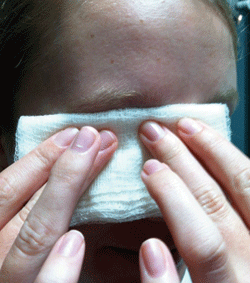 Dr. David Sackett, often referred to as “the father of evidence-based medicine,” is quoted as telling a class of medical students, “Half of what you’ll learn in medical school will be shown to be either dead wrong or out of date within five years of your graduation; the trouble is that nobody can tell you which half.”
Dr. David Sackett, often referred to as “the father of evidence-based medicine,” is quoted as telling a class of medical students, “Half of what you’ll learn in medical school will be shown to be either dead wrong or out of date within five years of your graduation; the trouble is that nobody can tell you which half.”
Optometry certainly has seen its share of discarded dogmatic practices. The water provocative test for glaucoma and the use of pressure patching for corneal abrasions were once taught as essential components of practice.
By 2013, however, we’ve realized that these procedures are outdated, overrated or just plain wrong.
Sometimes it can be difficult to accept that something you’ve been doing for many years is incorrect, inappropriate or even potentially harmful. But, as optometry becomes more sophisticated and research brings us new clinical evidence, we are bound to see a multitude of changes in many things once considered standard of care.
It was such a scenario after attending a lecture about meibomian gland dysfunction (MGD) and dry eye by Donald R. Korb, OD, at the 2012 American Academy of Optometry meeting in Phoenix. Dr. Korb alluded that the use of warm compresses with digital massage––a seemingly innocuous practice that most of us recommend for patients with blepharitis and chalazia––actually might be detrimental to corneal health.
It was just a brief mention, but it was noteworthy. And it seems that, over the last few years, several researchers have evaluated the potential for corneal warping when patients used combined heat and massage for eyelid conditions.
Hot Under Pressure
There is little question that warm compresses can have a positive impact on conditions like MGD and evaporative dry eye. In 2003, a paper authored by Mary C. Olson, BA, Jack V. Greiner, OD, DO, PhD, and Dr. Korb showed significant improvement in tear film lipid layer thickness following treatment with warm compresses in a series of 20 patients with MGD.1
Subjects were instructed to apply moist cotton napkins heated to 40°C to their eyelids using gentle pressure for a defined period of time. Their results showed an increase in lipid layer thickness of more than 80% after just five minutes of treatment; a subsequent 20% increase in lipid thickness was documented after 15 additional minutes of therapy.1
Nevertheless, we now know that vigorous eye rubbing has been associated with corneal deformities––including keratoconus in the most severe instances. In a 2009 publication, professor Charles McMonnies, PhD, detailed the mechanisms of rubbing-related corneal trauma, citing elevated corneal temperature as one of the factors that can promote keratoconic deformation.2
Such temperature increases can occur simply by closing the eyelids, but the act of pressing and rubbing on the lids and globes can exacerbate the process.
Corneal Deformation
In a small study conducted at the School of Optometry at the Hong Kong Polytechnic University, researchers examined the corneal reshaping effect of using hard-boiled eggs as warm compresses.3

Today, conventional therapy for most patients with MGD includes warm compresses and lid massage.
While it may sound unorthodox, many individuals around the world employ cooked eggs (and other food items) as heat-delivery systems for medical purposes, and research has actually confirmed that such foods retain and deliver heat better than wet washcloths.4
Three arms were analyzed in this study: group 1 used a hot, cooked egg wrapped in wet cloth held gently against the closed eyelid; group 2 similarly used a hot, cooked egg wrapped in cloth, but was told to simply hold it near the eyelid without touching it; and group 3 used a cold egg wrapped in wet cloth held gently against the eyelid.
All groups employed the therapy for a five-minute period. Researchers then compared corneal topography for each subject before and immediately after treatment.
Patients in groups 1 and 3 exhibited statistically significant differences in two corneal parameters––the surface asymmetry index and the surface regularity index. Group 1 subjects actually showed the greatest difference in corneal measurement, while those in group 2 demonstrated the least difference.
The researchers concluded that the pressure on the eyelids, especially when combined with heat, was the driving force behind the induced corneal distortion.3
In late 2012, Drs. McMonnies, Korb and Caroline Blackie, OD, PhD, described a 24-year-old dry eye patient with extreme corneal warping that they attributed to a regimen of warm compress therapy and digital lid massage for MGD.5 Corneal maps showed notable, bilateral changes in astigmatism, approaching what could only be described as pseudokeratoconus in one eye.
Their review of the literature yielded the following conclusions: “When combined with warm compresses or other methods of heat delivery to the eye, the elevation of corneal temperature appears to explain how meibomian gland dysfunction treatment involving warm compresses and massage could induce rubbing-related deformation. Patients whose management involves iatrogenic ocular massage appear to require screening for risk of corneal deformation. Risk may be increased for patients with a concurrent habit of rubbing their eyes abnormally in response to allergic itch, for example.”5
A July 2013 follow-up paper by the same authors evaluated the efficacy and safety of heat transfer to the cornea via warm compress therapy.6 The researchers found that temperatures approaching 40°C could be achieved with warm compresses and light pressure after just eight minutes of continuous application (the normal corneal temperature is approximately 36°C).
Vigorous rubbing may increase temperatures considerably and hasten the potential for corneal deformation––particularly in at-risk patients, such as those with keratoconus, axial myopia and glaucoma.6
So, how does this information impact our day-to-day practice? What should we tell patients regarding warm compress therapy for MGD, chalazia and other forms of eyelid inflammation? Based on the literature, it appears that the use of heat with gentle pressure is still beneficial for many conditions.
However, vigorous lid massage should be avoided in some patients––especially when combined with heat––because of the potential for corneal deformity and subsequent visual dysfunction.
Instead, alternative therapies that do not induce significant corneal heating and mechanical pressure, such as the LipiFlow Thermal Pulsation System (TearScience, Inc.), or therapeutic intervention with oral doxycycline and/or topical azithromycin may be more effective approaches for chronic lid disease management.
Drs. Kabat and Sowka have no direct financial interest in any of the products mentioned.
1. Olson MC, Korb DR, Greiner JV. Increase in tear film lipid layer thickness following treatment with warm compresses in patients with meibomian gland dysfunction. Eye Contact Lens. 2003 Apr;29(2):96-9.
2. McMonnies CW. Mechanisms of rubbing-related corneal trauma in keratoconus. Cornea. 2009 Jul;28(6):607-15.
3. Lam AK, Lam CH. Effect of warm compress therapy from hard-boiled eggs on corneal shape. Cornea. 2007 Feb;26(2):163-7.
4. Freedman HL, Preston KL. Heat retention in varieties of warm compresses: a comparison between warm soaks, hard-boiled eggs and the re-heater. Ophthalmic Surg. 1989 Dec;20(12):846-8.
5. McMonnies CW, Korb DR, Blackie CA. The role of heat in rubbing and massage-related corneal deformation. Cont Lens Anterior Eye. 2012 Aug;35(4):148-54.
6. Blackie CA, McMonnies CW, Korb DR. Warm compresses and the risks of elevated corneal temperature with massage. Cornea. 2013 Jul;32(7):e146-9.

